Learn whether the complicated fold accomplishes anything extra than the simple fold and how much tape is actually required to ensure a secure closure.
Murashev provides a detailed explanation of how to assemble a moving box in this section.
- Open the box by lowering the top flaps.
- Fold all of the edges into the interior of the box after turning it over. It is preferable to insert the smaller edges first, followed by the larger ones.
- Tape the box’s long, horizontal side using your packaging tape. For added support, tape the box’s side approximately halfway over.
What You’ll Need
Packing tape is the first and most crucial material you will need when putting together cardboard moving boxes. We advise getting several rolls of strong, weatherproof packing tape in addition to a dispenser that makes it simple to tape a box. You’ll require a pair of scissors on hand if your dispenser doesn’t have a sharp edge for ripping the tape. Finding a comfortable spot on the floor where you can spread out and begin folding boxes is also advised because it takes time. Last but not least, you’re going to need a lot of patience. Although folding boxes isn’t particularly enjoyable, there are ways to make it more tolerable. While folding, listen to a podcast or play your favorite playlist. The time will pass more quickly and packing will be more enjoyable as a result.
Assembling a Cardboard Box
Therefore, once you understand how to assemble one cardboard box, you can essentially do so for any size box, regardless of how big it is or what it will be used for.
The box needs to be opened first. If it is flat, divide the pieces into a top and a bottom using your hands. Right now, both will be wide open.
The next step is to crease the four tabs on the box’s bottom together. Begin by folding down one panel at a time; it doesn’t matter which one. Fold down the card immediately to its right, then the second and third.
The fourth panel should now be tucked underneath the first panel’s right side. Your cardboard box’s bottom will get a somewhat firm base as a result.

Reinforcing the Bottom
The four panels on the bottom of the box are now intertwined, but they are not strong enough to support the weight of the items you are trying to load into the box. Instead, you should use packing tape to reinforce the bottom.
The folded bottom should be facing you as you turn the box over. Then apply a lengthy strip of mailing tape or packing tape over the two bottom seams using a packing tape dispenser. Make sure the length of tape is sufficient to extend past the bottom of the box and adhere to the sides of the box for added support.
Don’t hesitate to cover the bottom of the box with several strips of packing tape.
Loading the Cardboard Box
It’s time to fill the cardboard box with the items you want to ship after the bottom has been securely fastened.
Be careful not to exceed the box’s rated weight capacity or to overfill the box with items. This needs to be noted on both the packaging materials it came in and the bottom of the box.
You should pack the box with something to keep your items in good shape in order to stop them from shifting or moving while being shipped. Inflatable plastic bags, packing peanuts, or even simply rolled-up newspaper can be used for this.
Once the top of the box has been folded and secured in the same manner as the bottom, your box is prepared for shipping.
How to Pack Moving Boxes
Moving box packing is a skill, believe it or not. If you just throw things into your cardboard moving boxes at random, you’ll probably end up with broken boxes in addition to your damaged possessions. We’ve gathered some useful advice on how to pack moving boxes for your impending move in order to assist you with your strategic planning for packing.
- Figure out the correct number of boxes needed before packing – Try our free, simple-to-use packing calculator to determine how many boxes your move will require. You just need to enter some basic moving-related information, and we’ll estimate the number of cardboard boxes you’ll need.
- Protect items with packing paper and plastic wrap – Before boxing up your house, make sure you’ve gathered enough protective packing materials to cover your valuable and delicate items. You might also require moving blankets, peanuts, dividers, and packing foam pouches in addition to packing paper and plastic wrap.
- Place heaviest items in small boxes – To keep them from shifting while in transit, heavy items like books, kitchen appliances, and fragile items should be packed inside smaller boxes. Additionally, using small boxes will keep you from overstuffing a cardboard box. Larger boxes should contain lighter items like pillows and utensils.
- Insert glass divider kits inside several cardboard boxes – We STRONGLY RECOMMEND INSERTING GLASS DIVIDERS KITS WITHIN A FEW OF YOUR BOXES TO AVOID BREAKAGE OF YOUR DINNERWARE, GLAS After inserting the dividers, pack the contents of the boxes with paper.
- Pack non-essentials first and essentials last – We advise boxing up your possessions in your home one room at a time. Non-essential items should be packed last. Think of items like books, artwork, picture frames, baskets, seasonal clothing, etc. that you most likely won’t need in the days or weeks before your move. Your kitchen necessities, such as dinnerware and utensils, may be among the essentials you pack last. Bedding, clothing, and electronics could be considered additional necessities.
- Label and color code boxes – Using a sharpie marker to label your boxes is a requirement when moving. You’ll waste time looking for your toothbrush and pillows, among other things, if you don’t. We advise going a step further and color coding the boxes in addition to labeling them. You and/or your movers will find it simpler to put boxes in the right locations if you do this. Many retailers sell products with color-coded labels. Alternatively, you can create your own color-coding system by using colored tape and designating a room for each color. Every box in the kitchen, for instance, will have green tape, and every box in the master bedroom, red tape, etc.
Where to Find Free Moving Boxes
Budget-conscious people will be relieved to learn that there are numerous locations where they can find free cardboard boxes. These second-hand boxes frequently come pre-assembled in addition to being a cost-effective option. These five locations all offer free moving boxes. Check here for more details on free moving boxes.
- U-Haul Box Exchange – The Customer Connect Box Exchange of the truck rental company enables users from all over the United States. to connect and find moving supplies. Just enter your location and/or “Free Boxes” in the keyword section to find someone nearby who is giving away moving boxes.
- Online community groups – To find free boxes in your neighborhood, check out your local online community groups on sites like Nextdoor.com and Facebook Marketplace.
- Recycling drop-off points – There’s probably one close to your house because most cities have numerous recycling drop-off locations. You’re sure to win the cardboard box lottery if you check it out on the weekend.
- Craigslist – Head to Craigslist’s “Free” section to find all sorts of free items up for grabs. Probably someone will be attempting to get rid of their pile of packing materials. If not, you can always post your own ad asking for unpaid boxes and supplies.
- Freecycle – Among other free household items, the Freecycle network is a great place to find moving supplies.) in your community. If you’re having trouble finding boxes, just post an ad on Craigslist explaining that you need some.

